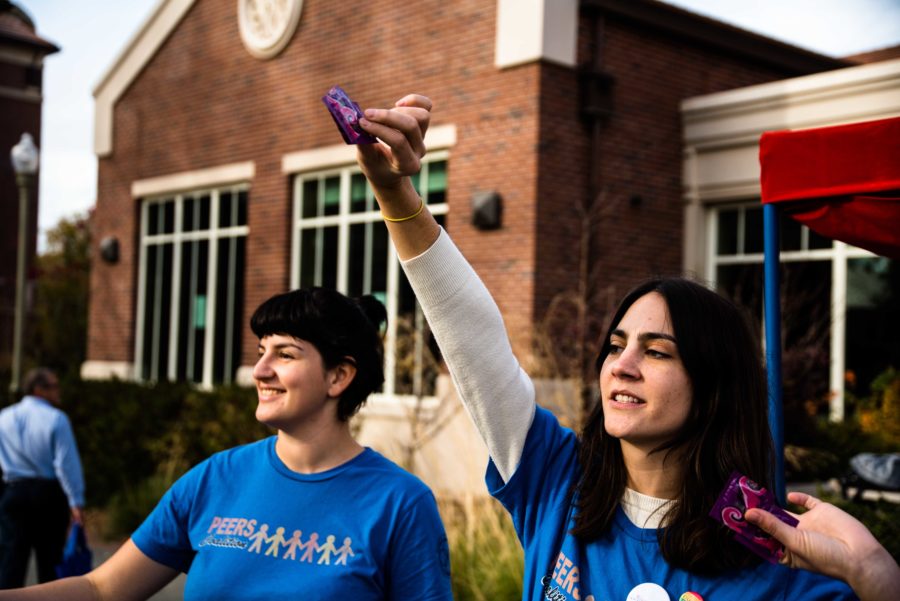Remembering to take a pill every day wasn’t easy for Santa Rosa Junior College biology major Jeannie LeGallee. The 21-year-old tried taking oral contraceptives as a form of birth control but found she would often forget to take them.
“I’m really bad at remembering and procrastinate things. An alarm would go off, and I’d say I’d get to it in two minutes and then forget,” LeGallee said.
Oral contraceptives didn’t work for her, so she sought out a new form of birth control because she isn’t ready to become a mother.
“I’m definitely focusing on studies and trying to improve my life situation rather than have a child and try to deal with that,” LeGallee said.
After talking with her doctor, LeGallee chose to switch to an arm implant. She found the risks and side effects comparable to those of the pill and shot methods. She said the arm implant is best for her because it allows her not to worry about taking a pill every day.
“I scheduled it and it took less than 15 minutes. It was honestly longer to wait in the waiting room than to get it done,” she said. “They cleaned the area and then did a numbing thing so you couldn’t feel it.”
LeGallee is one of the 62 percent of American women age 15 to 44 who currently use some form of contraception, according to Robert Hatcher’s text “Managing Contraception.” In his work, Hatcher said each night 700,000 to one million women in the U.S. have unprotected sex and do not want to become pregnant.
Condoms are available over the counter at drug stores, grocery stores and mass chains like Target. Clinics provide vaginal rings or female condoms. A trip to the doctor’s office can provide an IUD or oral contraceptives.
With an overabundance of birth control methods available, reproductive health texts and instructor Dr. J. Davis Mannino provide insight on the effectiveness and risks of several contraceptives; and in-depth interviews show what students are actually using.
The Methods
There are four major contraception approaches with various methods in each.
Barrier methods include condoms, diaphragms, sponges and cervical caps, which act as physical barriers preventing sperm from uniting with the egg.
Hormonal methods include “the pill,” Intrauterine Device (IUD), vaginal rings, patches, injectables and implants, which alter the biochemistry of a women’s body to prevent ovulation, making it more difficult for sperm to reach the egg if ovulation does occur. Emergency contraception, also known as the “morning-after pill,” is another hormonal method of birth control that keeps a woman’s ovaries from releasing eggs for longer than usual.
The implant is good for three years at a time, and LeGallee plans to renew hers when it expires because of its practicality. “No pain, discomfort. I mean you can feel it in there, it moves a little bit, it’s kind of flexible, but it’s just there,” she said.
While LeGallee is content with her arm implant, she said she wouldn’t recommend others getting it without being informed first. “It’s something that I would research definitely because there are all sorts of options,” she said.
Surgical methods include male sterilization, or vasectomy, and female sterilization – tubal ligation – which permanently prevents sperm or eggs from traveling to the site of conception.
Natural methods include withdrawal and fertility awareness-based approaches and do not require drugs or devices. These methods are more subject to human error.
“The best method is the one that is medically appropriate and is used every time by someone happy with the method,” Mannino said.
Effectiveness
Mannino noted every contraceptive method has a “typical use” and a “perfect use.” Typical use of a contraceptive method refers to how the average couple uses it, which could leave room for human error, resulting in the method not being used accurately or consistently. Perfect use of a contraceptive method describes the effectiveness of that method when used consistently and exactly as intended, which few couples are able to do flawlessly over a long period of time.
According to the World Health Organization Department of Reproductive Health and Research, the top four most effective contraceptive methods are implants, the IUD, male sterilization and female sterilization. Each of the top most effective products are in the high 90th percentile.
Mannino said fertility awareness-based methods, the withdrawal method and condoms rank in the least effective contraceptive methods. According to WHO, 24 out of 100 women who use fertility awareness-based methods and 18 out of every 100 who use condoms within the first year of typical use experience an unintended pregnancy.
Twenty-two out of every 100 women who use the withdrawal method with a male partner experience an unintended pregnancy within the first year of typical practice. “The withdrawal method, meaning pulling out right before ejaculation, is a very high [risk] method as pre-cum is filled with sperm,” Mannino said. “There is an old joke that goes: What do you call a man who uses the ‘withdrawal’ method? Answer: a father.”
Health Risks
Wondering about the safety of all these methods?
According to Robert Hatcher’s 2011 text “Contraceptive Technology,” barrier methods, spermicides and fertility awareness-based methods are the safest with no risk of death. IUDs are the next safest form of contraception with only one death out of every 10 million women who use it.
Nonsmokers aged 15-34 have only a one in 1.6 million chance of death using oral contraceptives (i.e. “the pill”), but this number drops to one in 57,800 for those aged 15-34 and one in 5,200 aged 35-44 who do smoke.
Mannino said when “the pill” was created in the 1960s, millions of women used it with few immediate side effects; however newer research has shown issues with the pill’s long-term hormonal modification, having researchers questioning whether it’s as harmless as first thought.
“I caution my students to consider other contraceptive choices, rather than use hormonal manipulation,” Maninno said. “Though I always caution that it really is a decision between them and their health care provider.”
Marine biology major Vini Souza, 20, said he is concerned for his girlfriend’s health while she uses the pill. “My girlfriend has been throwing up,” he said. “It upsets her stomach. She’s been wanting to get off of it and find another alternative.”
Tubal ligation, a female sterilization method of contraception, has a one in 66,700 chance of death. The chance of death resulting from pregnancy is nearly 10 times greater than that of tubal ligation, with the risk being one in 6,900.
What’s next?
A contraceptive method people have debated over and in and out of production is a male contraceptive pill.
“The ‘male pill’ has been a dream for some time. The reason we don’t have it, in my opinion, is the ugly truth called sexism – men come first!” Mannino said.
Kinesiology major Austin Guidry, 21, said he has never heard of the male contraceptive and is hesitant to take it in the future. His main hesitation is that it would affect his testosterone levels. “Why would we take something when it’s hormones for women,” he said. “Statistically, if it were proven to be safe with a large number, probably.”
Not all students are as skeptical about new forms of birth control. “If there were other options I would totally look into it,” Souza said. “Since I haven’t heard of anything, I’ve just been sticking with the norm.”
One male contraceptive in development is a nonhormonal gel injection called Vasalgel, which experts believe to be the first male contraceptive method FDA approved. Researchers predict it will be available for purchase between 2018 and 2020, according to Mannino.
“When the male pill transitions into mainstream society it will cause a major ground shake in life’s playing field of fairness and equity,” Mannino said.
Students like 33-year-old SRJC mathematics major Phoenix Von Esch would consider taking a male birth control contraceptive if it were proven safe. For now, he said his options are limited. “I use condoms, it’s what I know right now,” he said.
Von Esch had his first child when he was 27 years old. Afterwards he and his partner chose to take extra precaution. “I already have one kid; I don’t need another, she’s a lot of work,” Von Esch said. “[My partner] got an IUD after because we didn’t want any more.”
Education
Von Esch attended Santa Rosa Middle School, where he felt sexual education was a comprehensive program. He liked that instructors focused on educating him and his classmates instead of focusing on abstinence. “It’s not really taught in schools now, it’s more just ‘don’t do it’ and that’s not going to prevent anything in my opinion,” he said.
LeGallee went to Geyserville High School where she said she received a decent sexual education. She liked that her teachers encouraged students to talk to their partners about previous relationships, STI’s and whether they’ve been tested.
LeGallee wished the U.S. would start these classes earlier because she thinks it would open a discussion and break social stigmas. “If you’re upfront about it and you’re upfront with your partner about STI’s, you’re less likely to get them,” she said. “So I think if we normalized that, it would make it a lot easier to bring it up and reduce the stigma around birth control.”









Dru West • Dec 8, 2015 at 9:36 pm
I write this reply because my daughter Julia West, a graduate of SRJC died in 2013 from pulmonary embolisms while using the birth control NuvaRing. Since that time I have met survivors of deep vein thrombosis and pulmonary embolisms, strokes, heart attacks and many parents of other young women who died from the effects of NuvaRing, Beyaz and even some of the 2nd generation progestin birth control pills (the “safest” pills on the market).
I applaud the authors of this article for wanting to do a story about birth control, as it’s an important issue for women and men. I also was encouraged to read the quotes from Professor Mannino who said “when “the pill” was created in the 1960s, millions of women used it with few immediate side effects; however newer research has shown issues with the pill’s long-term hormonal modification, having researchers questioning whether it’s as harmless as first thought. Thank you professor Mannino for acknowledging that hormonal birth control is not as benign as the pharmaceutical companies would like you to believe.
It saddens me beyond words to read the citation from Contraception Technology, one of the bibles to health care professionals who prescribe birth control, as I know that the statistics they cite are just plain wrong. How can I refute such a revered medical resource? Well, right here in depth as now all I can post is this reply. I will state emphatically that there is a higher chance of dying than 1 in 1.6 million from birth control. There are 10.8 million women in the US on hormonal birth control. Using the 1 in 1.6 million figure as a reference, are you really going to believe that only 6.75 women die each year because of their birth control? Those that don’t die will have long term issues or damage to their bodies.
Contraceptive Technology also says that when a woman has a Venous Thrombotic Embolism (VTE) that 2/3 of them will be Deep Vein Thrombosis (DVT) and 1/3 will be a Pulmonary Embolism (PE). The book says that 5% of DVTs will result in death and 12% of PEs will result in death. Over the last 15 years newer progestins are used in hormonal birth control, and each new “generation” of progestins has shown to have higher rates for blood clots. The statistics for VTEs vary depending on the progestins used in a combination hormonal birth control. Early, 2nd generation progestin hormones (such as Levonorgestrel) has the lowest rate for VTEs while 3rd generation progestin hormones in birth control (such as Etonogestrel) have a higher rate for VTEs, and the 4th generation progestins, such as Drospirenone have a higher rate of VTEs.
The FDA only cites one range for VTEs on birth control pamphlets (3 to 12 per 10,000 for all CHC users), while the European Medicines Agency (EMA) uses ranges for specific progestins
Levonorgestrel, Norethisterone or Norgestimate – About 5-7 out of 10,000 women
Etonogestrel or norelgestromin – About 6-12 out of 10,000 women
Drospirenone, Gestodene or Desogestrel – About 9-12 out of 10,000 women
It saddens me even more that women are informed about all the annoying common side effects, but little is said to them about the less common but more dangerous and deadly side effects of hormonal birth control. Most women don’t even know what a blood clot can do to the body or that it can cause stroke, heart attack, pulmonary embolism and also death. In addition women aren’t educated about the signs to watch out for so they can get needed medical help quickly. Lastly, blood clots are hard to diagnose and are often misdiagnosed by many doctors as pneumonia, asthma, or muscle strain. You do not need to be a smoker or have a blood clotting disorder to get a blood clot.
I am now active with a group of others to try to improve safety information about hormonal birth control. Last week I just got a message from a mother whose 19-year-old daughter died in July while using hormonal birth control. She wanted to let me know that she will do anything to try to educate people about what hormonal birth control can do. The mother had been reading stories in the news about this product and tried to point them out to her daughter that there might be a serious risk, but the daughter replied, “Doctors wouldn’t be prescribing it if it was that dangerous.” This young woman is now dead.
I am all for effective and safe birth control. I am also not trying to scare women off hormonal birth control, although I know it probably sounds like I am. Many women use them with only a few annoying side effects and they are effective against preventing pregnancy. What I would like to see is that women learn about what hormones really do in their body beyond being effective at preventing pregnancy and that women become more aware of the signs and symptoms of a serious problem, so they can get help as soon as possible.
I would be glad to talk with anyone who would like to contact me.
Other sources about blood clots for women and discussion of symptoms can be found at womenandbloodclots.org a site developed by the National Blood Clot Alliance with funding from a family who lost their daughter due to pulmonary embolisms while using combination hormonal birth control. Stoptheclot.org also has patient stories (from both men and women) about blood clots.
Thank you for reading my reply.